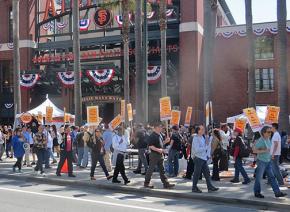Workers swing for the fences
, a delegate to the San Francisco Labor Council, reports on a victorious contract struggle by stadium concession workers in San Francisco.
HEY, BASEBALL fans, a big win was pulled out recently by the home team at beautiful San Francisco Giants stadium.
The Giants are one of the oldest and most successful sports franchises in the country with more Hall of Fame enrollees and more total games won than any other club. In fact, they have more "W's" than any other professional sports team in the entire nation.
But this latest come-from-behind victory didn't happen on the field where the Giants are (temporarily) experiencing a steep slump of sorts. Instead, it took place in the stands, where 800 seasonal concession workers organized by UNITE HERE Local 2 just ratified, by a 98 percent margin, a contract with Centerplate, the subcontracted concessionaire at Giants Park and one of the largest hospitality companies in North America.
The agreement provides the best wages and benefits in the country for their type of work. The terms included an immediate raise of $1.40 an hour with some back pay, strong job security protections, dental insurance and fully paid family medical coverage without co-pays through the contract's 2019 expiration date.

The agreement will also fund a big improvement in pension benefits and will tie future health care and wage increases to San Francisco's big hotels--so when Local 2 hotel workers get wage and benefit increases, Centerplate will match them at Giants stadium.
This convergence of interests is not accidental. Local 2 members regularly discuss the importance of solidarity. Membership unity across job classifications and work sites strengthens the union and, as results indicate, increases its bargaining leverage considerably.
HOW WAS this victory pulled out?
Local 2 is the largest private-sector union in the city and among its most vibrant and active. It's probably best known for mobilizing both members and community allies as part of a strategy that also, of course, includes the traditional bargaining format of advancing convincing arguments and solid research during talks with management.
But absent membership action enhanced by community support, we have seen most other unions struggle against the overwhelming material resources of employers.
Local 2 Field Representative Alphonso Pines explained Local 2's game plan. "Negotiations were going nowhere in 2012, so we started making house visits in early 2013, even before the season began, to speak personally with our members about the issues, about our goals and about our strategy," he said.
After general agreement on the plan, the union recruited an organizing committee of concession workers, which got stronger and stronger, eventually growing to between 40 and 50 workers. "Leadership and activism among the workforce was an essential part of our success," the union field rep emphasized.
For example, on May 25, 2013, workers conducted a one-day strike. The response was overwhelming with 97 percent participation as 545 workers walked the picket line all day long. Of course, this builds confidence.
"It was an amazing sight to see," Pines told me with lots of pride in his voice. "The workers never wavered in their resolve to get a fair contract, never stopped believing in themselves and never stopped believing in the union. The strike only further solidified their bond with each other."
This enthusiasm derives from a common appreciation of the stakes involved and the belief that victory is possible. Thus, Local 2's extensive community and labor outreach paid off by boosting morale as more and more showed up for protests at Giants Park.
"We want to thank the community and labor groups who helped us and to the many regular ticket holders and fans who also gave us great support," Pines said.


